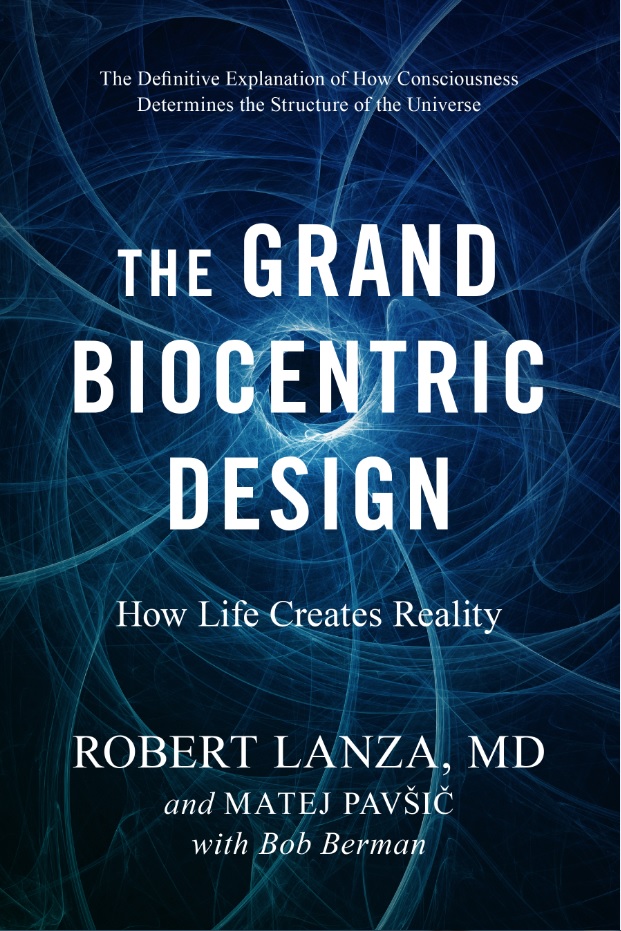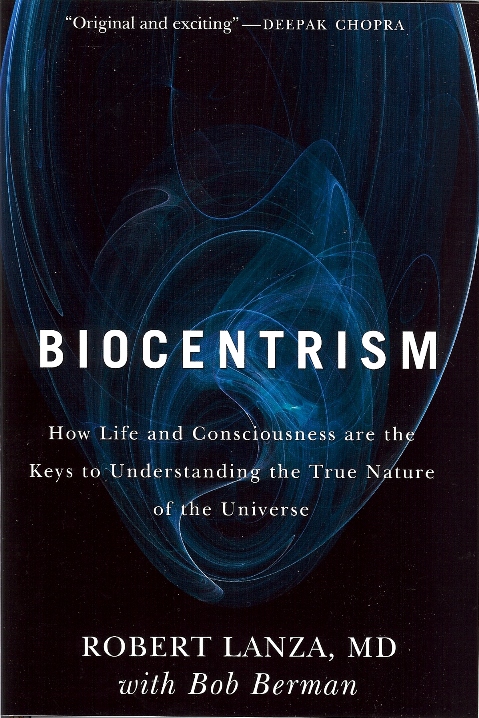The laws of physics don't care about our notions of 'time passing'—until you come along and give it a past, present, and future.

(Credit: lassedesignen/Shutterstock)
Adapted from The Grand Biocentric Design: How Life Creates Reality, by Robert Lanza and theoretical physicist Matej Pavsic, published by BenBella Books (2020).
Every story—including the epic narratives of our own lives—needs a framework, a skeleton. And every exciting story needs a villain. Time fulfills both requirements. For surely something must be blamed for the tragedy that transforms the beauty and vitality of our youth into the crepey skin and creaky joints of our aging selves.
This unspeakable crime’s perpetrator was long considered an actual entity. Even great minds like those of Newton considered time a stolid feature of reality, an actual dimension through which all else passes. That notion of time as an absolute thing, ticking away outside of us, has never fully left the public mind. In 2014’s sci-fi hit, Lucy—in which the title character, played by Scarlett Johannsson, is able to transcend many physical and mental constraints after being dosed with a drug—the brilliant scientist (played by Morgan Freeman) grandly informs us at the film’s climax that time alone is real.
But the screenplay’s writer could not have based that pronouncement on anything found in a modern physics text. Indeed, time’s lack of reality is in some sense old news, going back at least to the head-spinning revelations of relativity.
In his papers on relativity, Einstein showed that time was relative to the observer. Biocentrism takes this a step further by suggesting that the observer doesn’t just perceive time, but literally creates it. Most people take for granted the reality of what our minds put together. We understand dreams as a mental construct, but when it comes to the life we live, we accept our perception of time and space as absolutely real. But in fact, as explained in the new book The Grand Biocentric Design, space and time are not objects. Time is simply the ordered construction of what we observe in space—much like the frames of a film—occurring inside the mind.
According to biocentrism, these mental constructs are based on algorithms whose physical logic is contained in the neurocircuitry of the brain. The particular algorithms your brain uses to translate the welter of perceptions flooding your senses into a coherent lived experience are the key to consciousness, and they also explain why time and space—indeed, the properties of matter itself—are relative to the observer.
In the end, life is motion and change, and both are only possible through the representation of time. At each moment we are at the edge of a paradox known as “The Arrow,” first described 2,500 years ago by Zeno of Elea. Since nothing can be in two places at once, he reasoned that, during any given instant of its flight, an arrow is in only one location. Thus, at every moment of its trajectory, the arrow must be present at some specific place. But if the arrow is in one specific place, it follows that it must momentarily be at rest. Logically, then, as the arrow flies from bow to target, what is occurring is not motion per se, but a series of separate static events. The forward motion of time, embodied by the movement of an arrow, is not a feature of the external world but a projection of something within us that ties together things we are observing.
In 2016, one of the authors of The Grand Biocentric Design (Lanza) published a scientific paper with Dmitriy Podolskiy, a theoretical physicist then working at Harvard.
The paper appeared as the cover story in Annalen der Physik—coincidentally, the same journal that published Einstein’s theories of special and general relativity. It explains how the arrow of time, and time itself, emerges directly from the observer: that is, from us. Time, it argues, does not exist “out there,” ticking away from past to future, but rather is an emergent property that depends on an observer’s ability to preserve information about experienced events.
Time is inarguably a relational concept—one event relative to another. Time as we experience it has no meaning without association to another point. Thus, it requires an observer with memory; without such an observer, one cannot have the relational concept that lies at the core of any “arrow of time.”
To the bafflement of scientists, the fundamental laws of physics have no preference for a direction in time, and work just as well for events going forward or going backward in time. Yet, in the real world, coffee cools and cars break down. No matter how many times you look in the mirror, you’ll never see yourself grow younger. But if the laws of physics are symmetric with respect to time, then why do we experience reality with the arrow of time strictly directed from the past to the future?
WAVE FUNCTION COLLAPSE
The key to the nature of time is quantum gravity. During the last century, it became clear to physicists that the world of relativity (which deals with objects at large distances) and the world of quantum mechanics (which describes reality at small distances) are incompatible with each other. The problem of making them compatible, known in theoretical physics as the problem of “quantum gravity,” remains perhaps the largest unsolved mystery of science despite intensive efforts by some of the greatest minds of the century.
Cracking the puzzle of quantum gravity requires us to go back to the foundations of quantum mechanics, which remains as puzzling to students and experienced scientists as it was to Einstein over half-a-century ago. Perhaps the most puzzling feature among them is called “wave function collapse.”
To understand the problem, consider the light in your room. Common sense tells us that the light is either on or off, but not both at once. Yet, quantum mechanics allows such bizarre states (called “entangled”), in which the lights have been neither turned on or off. Instead, they exist in a “superposition” of the two states — that is, both “on” and “off.”
Experiments confirm that entangled states exist at microscopic, scales, at the size of atoms or elementary particles. But if the laws of quantum mechanics are universal, why don’t we observe entangled states of macroscopic objects surrounding us? The famous Schrödinger’s cat experiment suggests that even cats and people can exist in an entangled state, i.e. they can be both “alive” and “dead” at the same time. If so, then why do real life cats always seem either dead or alive?
The answer, as was suggested by the founding fathers of quantum mechanics, is called “wave function collapse” or “decoherence.” The light becomes either permanently on or off—or Schrödinger’s cat alive or dead—if we, the observer, measure its state. When we measure the quantum state, we destroy its coherence.
THE ARROW OF TIME EMERGES
Einstein’s collaborator, John Wheeler (who coined the word “black hole”) argued that time itself emerges due to a decoherence of the wave function describing the universe, which is subject to the laws of quantum gravity. However, the intrinsic properties of quantum gravity and matter alone can’t explain the tremendous effectiveness of the emergence of time and the lack of quantum entanglement in our ordinary, everyday macroscopic world. Instead, it is necessary to include the properties of the observer, and in particular, the way we process and remember information. The emergence of the arrow of time is related to the ability of observers to preserve information about experienced events.
For years physicists have known that Newton’s laws, Einstein’s equations, and even those of the quantum theory, are all time-symmetrical. Time plays absolutely no role. There is no forward movement of time. Thus, many scientists question whether time even exists. Indeed, Einstein’s theories of relativity suggest not only that there is no single special present but that all moments are equally real.
So if the laws of physics should work just as well for events going forward or going backward in time, then why do we only experience growing older? All our scientific theories tell us that we should be able to experience the future just like we experience the past.
The answer lies in us observers—specifically, in our function of memory. If time is truly symmetrical in equations stretching from Newton to modern quantum mechanics, then science would seem to say that we should be able to “remember” the future just as we experience the past. But quantum mechanical trajectories “future to past” would be associated with the erasure of memories, a decrease in entropy leading to a decrease of entanglement between our memory and observed events. Hence you can’t go back in time without information being erased from your brain; if we do experience the future, we are not able to store memories about such experiences to “remember” back in our present. By contrast, if you experience the future by traveling the usual one-way path, “past > present > future,” the random process of entropy continues, and you continue to only accumulate memories.
So aging, too, offers no proof of time’s arrow as an external force. It seems that time truly does not exist outside of awareness; it is consciousness itself, by being accompanied by mechanisms like memory that allow for comparisons, that ushers in the arising of time as surely as the sunrise dispels the night.
In the world of biocentrism, a “brainless” observer—that is, one without the ability to store memory of observed events—does not experience a world in which we age. But it goes further and deeper than this: a brainless observer does not merely fail to experience time—time does not exist for such an observer in any sense. Without a conscious observer, the arrow of time—indeed, time itself—simply doesn’t come into existence in the first place.
Einstein was right when he sent a letter of condolence saying, “Now Besso [an old friend] has departed from this strange world a little ahead of me. That means nothing. For us believing physicists the distinction between past, present, and future is only a stubbornly persistent illusion.”
Lanza’s new book “The Grand Biocentric Design” lays out his theory of everything.




